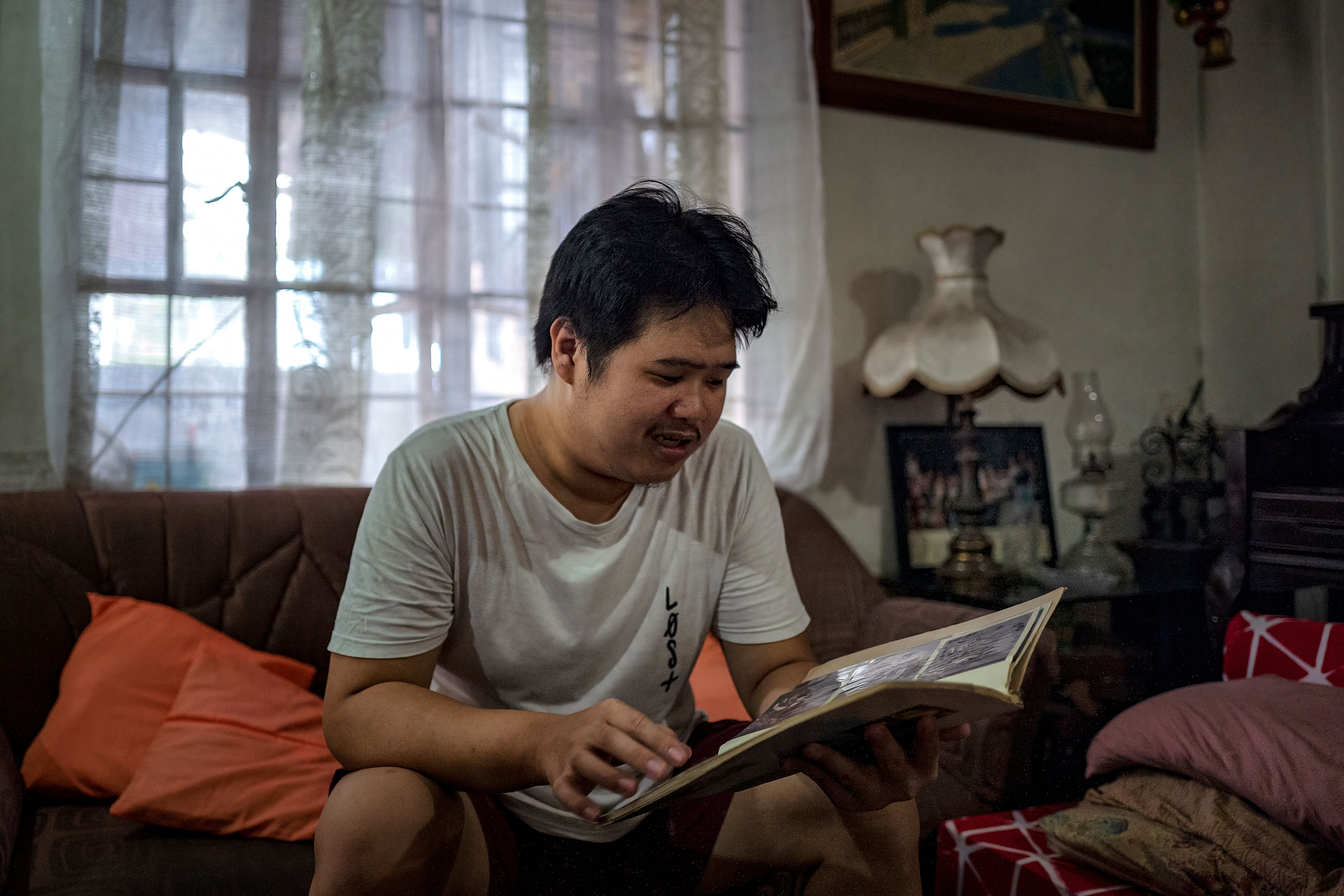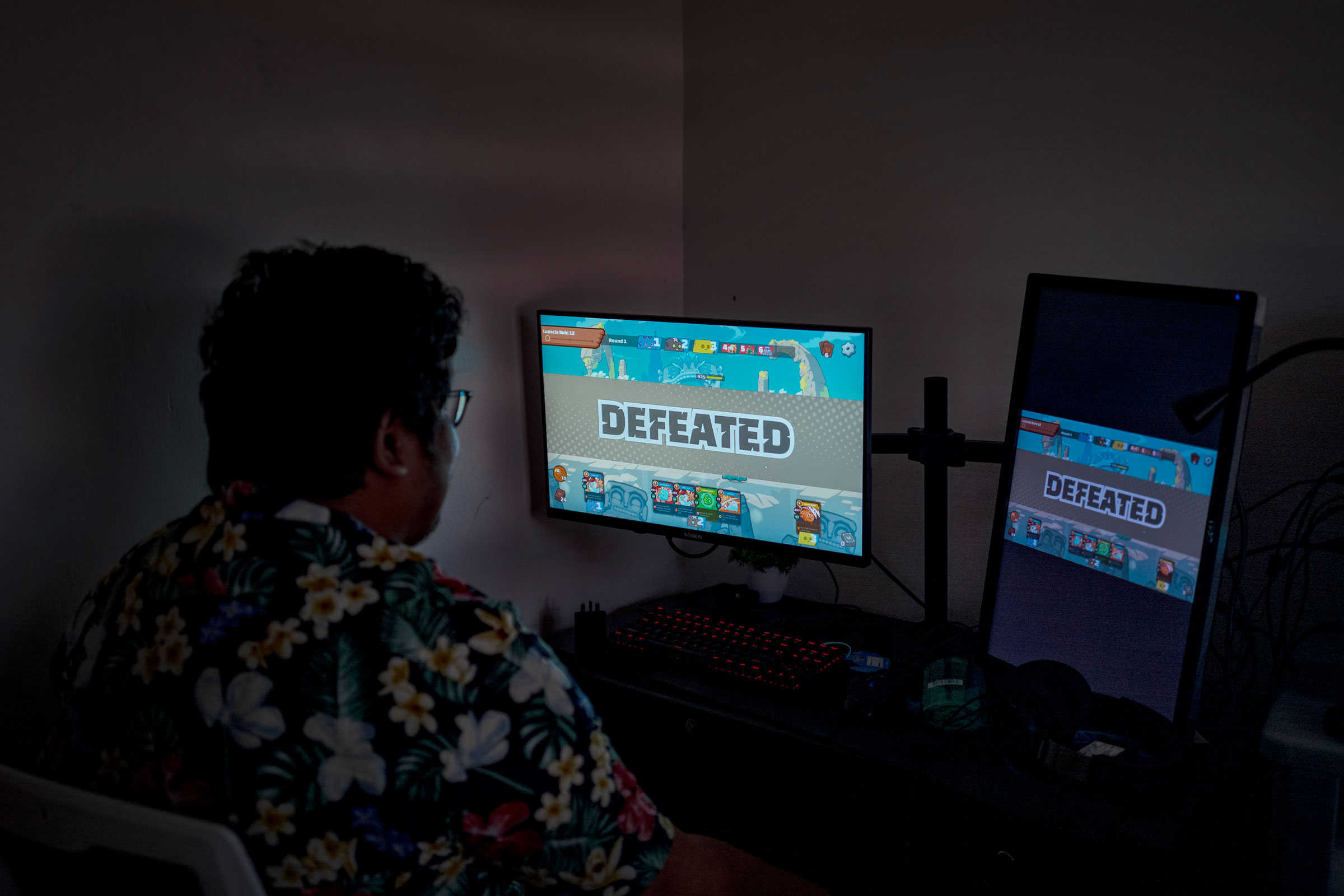[ad_1]
Samerson Orias was working as a line prepare dinner final yr within the rural Philippines when his good friend instructed him he might make far more cash taking part in a brand new online game.
Orias was incomes about 4,000 pesos a month (about $80, rather less than half the nationwide minimal wage) making takoyaki—Japanese octopus balls. His good friend instructed him he and others had been pocketing as much as $600 a month taking part in Axie Infinity, a sport fueled by cryptocurrency and NFTs.
Orias, now 26, desperately wanted an escape hatch from his monetary woes: his mom had had a stroke and required treatment, and electrical energy and grocery payments had been stacking up. So he plunged into Axie, doing battle with cartoon monsters for hours deep into the night time. He quickly started incomes cryptocurrency, which he transformed into pesos, permitting him to take higher care of his mom and his residence. On the identical time, 1000’s of younger folks within the Philippines had been leaping headlong into the sport. For a short second on the peak of crypto’s astonishing 2021 increase, these younger Filipino gamers had been fulfilling a longtime dream of crypto’s most ardent evangelists: that “play-to-earn” blockchain video games like Axie might cleared the path to a extra equitable, opportunity-rich world economic system.

Orias views household footage at his residence.
Ezra Acayan for TIME

Orias cooks at a Takoyaki store.
Ezra Acayan for TIME
Fourteen months later, most Filipino gamers, together with Orias, have exited the sport nursing anger and nervousness—and, in some circumstances, 1000’s of {dollars} down. Orias grew to hate taking part in the sport. It was boring and aggravating, he says, a standard chorus among the many dozen gamers TIME interviewed for this story. “I felt fatigued on a regular basis. I turned extra aggressive in each side of my life,” he says.
The story of Orias and Axie Infinity serves as a cautionary story for crypto and its bombastic rhetoric about altering the world. Many crypto thought leaders, when rebutting criticism in regards to the unsavory elements of the house, level to its affect in creating international locations. However Orias and others say that Axie Infinity bolstered predatory programs and gave them false hope. Progressive metaverse concepts like Axie Infinity provide immense promise—but in addition tangible peril for individuals who really feel they don’t have any different possibility however to make the leap into the digital unknown.
The Play-to-Earn Dream
At first blush, Axie Infinity appears to be like lots like Pokémon. To enter the sport, gamers purchase three cutesy cartoon monsters known as Axies, every of which has its strengths and weaknesses. They then battle different Axies, which makes them extra highly effective. Alongside the way in which, gamers earn in-game forex known as Clean Love Potion (SLP), which might be exchanged for different cryptocurrencies. You may as well promote your Axie or breed new, extra invaluable monsters. Every Axie monster is an NFT: a novel non-fungible token whose possession is recorded on the blockchain, a safe ledger of transactions. This expertise has been touted by many as a possible spine of metaverse improvement.
Axie Infinity was created by a Vietnam-based startup known as Sky Mavis Inc. as a part of the rising play-to-earn gamer motion. For different in style video games like League of Legends and Fortnite, it’s widespread for elite gamers to make a residing by sponsorships and income from streaming their video games to on-line viewers. With Axie Infinity, the incomes potential is baked proper into the sport play itself. “We consider in a world future the place work and play change into one,” the sport’s web site said final yr.
Sky Mavis takes a lower of in-game transactions and sits on a big stash of tokens. By final October, the corporate had raised greater than $150 million from buyers together with the venture-capital agency Andreessen Horowitz.
The sport initially made a huge effect within the Philippines. At one level, gamers there made up 40% of the sport’s consumer base. Roughly 1 / 4 of the Southeast Asian nation of 110 million folks lives under the poverty line, and its economic system is closely depending on some 2.2 million migrant employees who ship a refund residence. However because the pandemic shut borders throughout the globe and slashed jobs, many of those employees had been despatched residence. As extended COVID-19 lockdowns crippled the native economic system, many resorted to a number of money-making schemes to make ends meet.
Owen Convocar, a Rizal-based gamer, heard murmurs about Axie’s incomes potential for months in early 2020 earlier than he determined to enter the sport as a scholar. In 15 days, he earned $487. He quickly invested $1,200 to purchase his personal Axie monsters, splitting the full price 60/40 along with his mother.
The early pandemic-era victories of gamers like Convocar introduced world information protection and tons of of 1000’s of latest gamers into the sport. However as the sport’s recognition elevated, observers identified that its financial construction was unsustainable: the worth of SLP necessitated new gamers frequently shopping for in, very like a Ponzi scheme. Sky Mavis’ crew even acknowledged in its white paper that the sport was “depending on new entrants.”
“Specializing in rising a community by early incentives doesn’t make a Ponzi scheme,” a consultant for Sky Mavis wrote in an e-mail to TIME. “Axie Infinity’s most important function is to supply leisure.”
As the worth of SLP continued to shoot up final summer season, many aspiring gamers discovered themselves unable to afford the price of buying their starter monsters. So an employment scheme emerged during which wealthier buyers, often called “managers,” would purchase Axie monsters after which lend them out to “students,” who would deal with the grunt work of leveling up. The homeowners of the monsters would then pocket anyplace from 30% to 50% of the students’ income, based on gamers interviewed by TIME. The system was unregulated, with Axie homeowners forging the phrases of the contracts, which they portrayed as a method to unfold the wealth. Orias hoped to be one of many system’s beneficiaries final Could, when he signed up with a supervisor based mostly in Australia. The supervisor required him to earn a minimal of 120 SLPs a day—which might take 5 to 6 hours of sport play—and would pocket half of Orias’ earnings.

Albert Oasnon, an Axie “supervisor”, performs the sport at his residence in Imus, Cavite, within the outskirts of Manila, Philippines, on July 19, 2022. Oasnon, who works in content material advertising and marketing and in addition runs a small media firm, says that through the sport’s peak final yr, he was managing round 20 students.
Ezra Acayan for TIME
So Orias developed a each day routine during which he cooked takoyaki from 3 p.m. till midnight, got here residence, and performed Axie by the wee hours of the morning. His play earned him badly wanted money: about $29 every week, after giving the identical quantity to his supervisor. However his relentless schedule, and the sport’s randomness, exhausted and pissed off him. “At first I used to be comfortable. However after a while, I seen I used to be slowly getting weaker. There was sleeplessness and the stress of the sport,” he says.
And in August, Orias would come again to the sport every week to seek out the real-world worth of in-game forex was falling. As extra gamers entered the sport and generated increasingly SLP tokens, every token’s worth decreased. By November, the analysis agency Naavik reported that common earnings for Axie students had dropped under the Philippines’ minimal wage.
By spring 2022, the underside had fallen out of the crypto market, making taking part in the sport practically nugatory. Whereas Axie Infinity boasted over 2.7 million each day energetic customers final November, solely 760,000 are nonetheless energetic, based on one tracker. The worth of SLP peaked at $0.34 final July; it’s at the moment price lower than half a penny.
And as Sky Mavis tried to tinker with its sport design to make it viable once more, a a lot larger catastrophe hit. In March, a hacker focused the “bridge” upon which cash was transferred between Sky Mavis’ blockchain Ronin and the a lot bigger cryptocurrency Ethereum. (Bridges between chains are one of many least safe elements of blockchain ecosystems.) Greater than $600 million was shortly drained from the community, with two-thirds of that belonging to customers themselves. Whereas Sky Mavis returned all funds, the hack demoralized the sport’s consumer base.
For the time being, Sky Mavis is making a tough pivot, de-emphasizing Axie’s “play-to-earn” nature and introducing a brand new model, Axie Infinity: Origin, that doesn’t contain crypto in any respect. They hope gamers will stick round for the sport play itself, and to make cash by in-game experiences and purchases.
In the meantime, huge quantities of cash are nonetheless being pumped into the blockchain gaming business. In April, the gaming group Prepared Participant DAO acquired a $150 million valuation in a brand new $10.2 million funding spherical. However Ethan McMahon, an economist on the analysis agency Chainalysis, says Axie’s failures portend badly for crypto’s as soon as rosy play-to-earn future. “Perhaps a choose group of the very best gamers will truly have the ability to earn from video games. However any given particular person’s beginning motivation to play is not going to simply be for revenue,” he says.
And Filipino students, who had been instructed that blockchain video games would convey radical financial change, are strolling away confused and jaded. A number of students TIME talked to stated they owe tons of and even 1000’s of {dollars} to mates or household who helped them pay the preliminary funding, just for their monsters to change into nugatory. Convocar’s Axie account was hacked in March, and recouping his losses set him again some $190. “I took excellent care of my Axies, and my account turned invalid,” he tells TIME. He quickly give up.

Orias (proper) and his childhood good friend Jonathan Artates at their Takoyaki store in San Mateo, Rizal, within the outskirts of Manila, Philippines, on July 19, 2022. It was Artates who introduce Orias to the Axie Infinity sport. He has additionally give up the sport after his account was hacked.
Ezra Acayan for TIME
Orias drifted away from the sport towards the tip of final summer season, after his mom died of a coronary heart assault. Her funeral worn out his financial savings, together with the $200 he had saved up taking part in Axie. “I felt remorse that I wasn’t in a position to present for my mother,” he says.
Now he’s again within the takoyaki stand, and hopes to avoid wasting up for a meals stand of his personal. “For these having a tough time, for these pushed to their wit’s finish,” he says of Axie, “cease taking part in.”
—With reporting by Julia Zorthian
Extra Should-Learn Tales From TIME
[ad_2]
Source link




